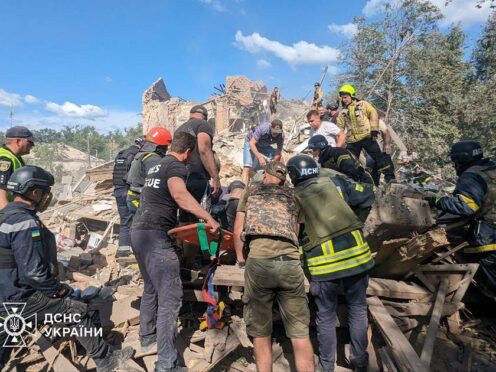Russian forces have launched new deadly attacks on Ukraine, killing at least nine people on Wednesday, a day before the leaders of countries that are some of Ukraine’s biggest backers were to discuss how to slow Moscow’s offensive.
Ukrainian authorities said that along with the nine killed, 29 others, including five children, were wounded when Russian missiles hit an apartment block in Kryvyi Rih, which is President Volodymyr Zelensky’s hometown.
Mr Zelensky said the strike has again proven that “Ukraine, together with its partners, must strengthen its air defences” — something that he has repeatedly appealed for with Ukraine’s western partners.
The United States has agreed to send another Patriot missile system, two US officials said late Tuesday.

“Modern air defence systems are capable of providing maximum protection of people, our cities, and our positions,” Mr Zelensky said. “And we need as many of them as possible.”
Earlier on Wednesday, Ukraine’s air force said it shot down more than two dozen air targets, including cruise missiles, a Kinzhal ballistic missile and Shahed drones. Several people were wounded, authorities said.
Kyiv’s outgunned and outnumbered forces are battling to hold back the bigger Russian army, which is trying to exploit Ukrainian vulnerabilities.
Ukraine has been short of troops, ammunition and air defences in recent months as the Kremlin’s forces try to cripple the national power supply and punch through the front line in eastern parts of the country.
Ukraine will need to weather the Russian onslaught through the summer, military analysts say, and in the meantime train more soldiers, build fortifications and hope that the provision of western military aid picks up speed so that in 2025 Kyiv may be able to mount its own offensive.
Several diplomatic events over the next few days are aimed at how to help Ukraine fend off the Russian invasion or how to bring about an end to the war.
Another attack by Russian terrorists this night. Recovery efforts are underway. The occupiers attempted a combined missile and drone strike on our country. Our air defenders responded effectively, shooting down five enemy missiles and more than 20 drones.
Such a result in… pic.twitter.com/EW1RecuMmH
— Volodymyr Zelenskyy / Володимир Зеленський (@ZelenskyyUa) June 12, 2024
On Thursday, US President Joe Biden and the other G7 leaders will gather in Italy for their annual summit to discuss ways to help Ukraine, including how to divert more frozen Russian assets to Kyiv’s defence.
Separately, the Biden administration on Wednesday said it had broadened sanctions against Russia by targeting companies that help Moscow’s war effort and raising the stakes for foreign financial institutions that work with sanctioned Russian entities.
The more than 300 new sanctions are largely aimed at deterring individuals and companies in countries such as China, the United Arab Emirates and Turkey from helping Moscow circumvent western blocks on obtaining key technology.
They also threaten foreign financial institutions with sanctions if they do business with almost any sanctioned Russian entity, underscoring the US view that the Kremlin has pivoted the Russian economy on to a war footing.
Mr Biden and Mr Zelensky will also sign a bilateral security agreement between the US and Ukraine on Thursday, when they meet on the G7 summit’s sidelines, the White House said.
National security adviser Jake Sullivan said the agreement would not commit US troops directly to Ukraine’s defence, but that it would demonstrate the US supports the people of Ukraine and serve as a “bridge” to when Ukraine is invited to join the Nato alliance – a long-term priority of Mr Zelensky’s that alliance members have said will first require an end to the war.
Separately, Mr Sullivan noted that Russian authorities have deported hundreds of thousands of Ukrainian civilians to Russia, including children who have been forcibly separated from their families. He cited reports of Russia listing abducted Ukrainian children on Russia’s adoption websites, denouncing it as “despicable and appalling”.
“These Ukrainian children belong with their families inside Ukraine,” Mr Sullivan said. “Russia is waging a war not just against the Ukrainian military – but against the Ukrainian people.”

While the G7 meets in Italy, defence chiefs from the US, Europe and other nations will meet on Thursday in Brussels for their monthly meeting on Ukraine’s security needs. US defence secretary Lloyd Austin will host the event.
And this weekend, representatives of nearly 90 countries and organisations, half from Europe, are expected to attend a summit in Switzerland aimed at charting a path to peace between Russia and Ukraine, though Russia will not be attending.
Both sides in Europe’s biggest conflict since the Second World War have been reaching out to friendly nations to help keep their armed forces supplied. The war has cost tens of thousands of lives on both sides, including more than 11,000 Ukrainian civilians, according to the United Nations.
While Ukraine has looked to western countries, Russian President Vladimir Putin has turned to nations such as Iran and North Korea for help. Unconfirmed reports suggested Mr Putin may soon make a third visit to North Korean leader Kim Jong Un.
Fighting along the roughly 620-mile front line has in recent months focused on the partly occupied Donetsk region of eastern Ukraine, where Russian forces are trying to reach the key hilltop city of Chasiv Yar and other strategic hubs.
Last month, Russian forces also launched an offensive in Ukraine’s north-eastern region of Kharkiv, which borders Russia. Mr Putin said he wanted to establish a buffer zone there to prevent Ukrainian cross-border attacks. The offensive drew some Ukrainian fighters away from Donetsk.
However, Russia’s gains have been incremental and costly.
In the Kharkiv region, Russian units have become bogged down in Vovchansk, Ukraine Commander in Chief Oleksandr Syrskyi said on Wednesday on the Telegram messaging app.
